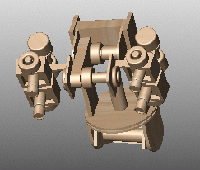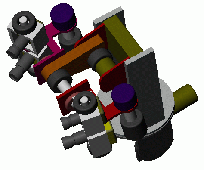


Initial Prototype Model of the Active Vision Head
Each eye has two cameras to simulate human's vision – the top cameras are B/W high resolution cameras, that acquire a image within a small range of view; and the two lower cameras are color low resolution cameras that acquire images within a large range.
The basic eye movements made by awake, frontal eyed, foveal animals are: saccades, smooth pursuit, vergence, physiological nystigmus, vestibulo ocular reflex - also known as vestibular nystigmus - and opto kinetic nystigmus:
- Saccadic eye-movements consist of very rapid ballistic motions that focus a target on the fovea (the central area of the visual field). Since the animal does not see well during these movements, these eye-movements are not controlled by visual feedback during their execution. In humans, saccades are extremely rapid, often up to 900 degrees per second.
- Smooth pursuit movements are slow and accurate movements of the eye, to keep the target on the fovea.
- Vergence movements adjust the eyes to view a moving target at different depths.
- The physiological nystigmus movements are extremely small movements consisting of drifts, high frequency tremor and micro saccades that are continuously present during fixation to a given target.
- The vestibular movements are automatic movements induced by the semicircular canals of the vestibular system. Acceleration measurements from both the semicircular canals and the otolith organs in the inner ear are integrated to provide a measurement of head velocity. This measurement is used to compensate for fast head rotations and/or translations by counter-turning the eyes to stabilize the image on the retina, maintaining the direction of gaze. During head rotations of large amplitude, saccadic movements usually interrupt these movements.
- Slow, smooth motions are compensated by the Opto-Kinetic-Nystigmus, by measuring the optical flow of the background on the retina (visual slip). The opto-kinetic nystigmus occurs, for example, when looking through the window of a moving train.
Drawing of the Vision Head
The robotic body where the head is mounted is a four-legged robot. When walking or running for executing a desired task, this body will introduce translation as well as rotation movements on the base of the stereo head. If the eyes are gazing to a target, these movements will move the fixation point away from the target. The goal is then to move the robotic head to maintain the fixation point on the target. Accelerometers and gyroscopes will be used as inertial sensors to measure these movements. Knowing that the movement of the base of the head relative to the target is a relative movement, the problem can be reformulated as the target being moving relative to the head, assuming that it is possible to measure the target movement (for example, using visual processing). This way, the algorithm used to stabilize the vision head using inertial sensors is precisely the same used to follow the target when the latter is moving. Furthermore, the same algorithm will be explored to perform different behaviors, such as approaching to a target and performing movements around it.
Inertial sensors will be mounted on the head to measure body motions. This head will have three rate gyroscopes (to measure angular velocity) mounted on orthogonal axes (corresponding to the semicircular canals) and three linear accelerometers – which measure linear accelerations - (corresponding to the otolith organs). Linear velocity is obtained by integrating linear accelerations and linear and angular positions are obtained by integrating the correspondent velocities. This technique provides good results for transient and rapid head motions. However, it has two drawbacks: with the integration of the measurements, the system tends to accumulate drift, and the scaling constant for the integration must be selected empirically.
Encoders are used to measure rotations of the neck and eyes joints. One encoder is placed attached to the shaft of each revolute joint motor, to measure angular velocity. Angular position is obtained integrating the velocity measurements.
The problem of stabilization consists of compensating body movements by moving the head so that the target is always on the foveal image viewed from the eyes. With the goal of stabilizing images acquired in real-time (frame-rate of 30 frames per second), the stabilization procedure must be executed at least twice as fast as the visual frame-rate. The movements of the robotic head must resemble movements of a human (or other animal) like head. Therefore, instead of moving first the eyes to compensate for body motions, and then moving the neck along the direction defined by the cyclope eye of the head and the target, it is preferred to move neck and eyes simultaneously. This has two main advantages: maximizes the range of possible motions for the next movement, giving simultaneously to the robot a more life-like appearance.
Working Model 3D simulations for the Head model
A Genetic Algorithm was implemented to solve for the 3 extra degrees of freedom due to redundancy. Results were obtained for different behaviors: stabilization and target pursuit and approaching the target and moving to as far as possible from the target.
[Motivation], [Overview], [People], [Publications], [Video]

